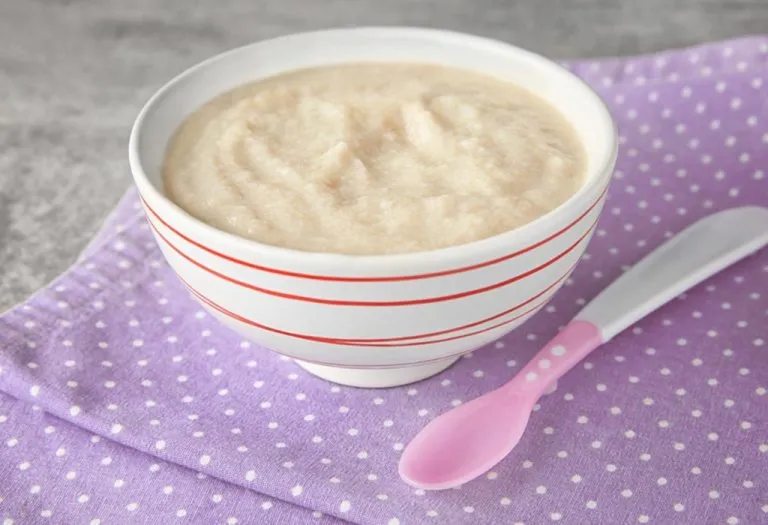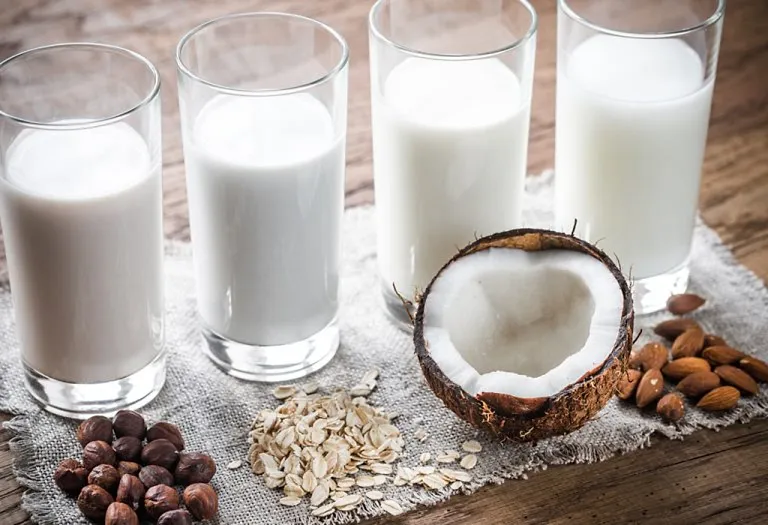Homemade Health Mix Powder (Sathu Maavu) for Babies

- What Is Sathu Maavu/Health Mix Powder?
- Why Is It Recommended to Give Homemade Sathu Maavu to Your Baby?
- Nutritional Value of Homemade Sathu Maavu
- Why You Shouldn’t Go for Packaged Baby Powder
- Benefits of Home-Made Sathu Maavu
- Sathu Maavu/Health Mix Powder Recipe
- Precautions
- Sathu Maavu Porridge Recipe for Babies
- Feeding Tips
- How To Store Sathu Maavu?
Many baby health mix powders are available. And they’re also easy to prepare – mix the ready-made powder with water, and you’re done! But with packaged products, you may compromise your infant’s health. Home-cooked food is any day better than processed food. If you seek a nutritious, hassle-free solution to feed your little one, look no further! A warm and comforting homemade health mix powder, Sathu Maavu, is a versatile and wholesome blend specially crafted for babies. Packed with essential nutrients and goodness, this homemade baby food is here to revolutionise your infant’s meal times. Say goodbye to store-bought options and embrace the simplicity and goodness of this homemade treat that will leave your baby craving more! In this article, we’ll tell you the benefits of this homemade cerelac for babies called sathu maavu, and how you can prepare and store it.
Video: How to Make Sathu Maavu for Babies?
What Is Sathu Maavu/Health Mix Powder?
Sathu maavu (a name that originated from South India) or Sathu (commonly called in the Northern parts of India) is a powder babies can consume after 6 months of age. Grains, cereals and pulses are powdered and mixed with water to make healthy baby porridge. Some ingredients can also sprout overnight to increase their nutritional content.
This homemade health mix benefits babies and can also be enjoyed by individuals of all ages. It is a wholesome alternative to processed foods, providing sustained energy and aiding in healthy growth and development. Its versatility allows it to be prepared in various forms, such as porridge, pancakes, or even added to baked goods like cookies and muffins. One of the key advantages of Sathu Maavu is that it can be customised to suit individual preferences and dietary requirements. For instance, additional ingredients like cardamom, turmeric, or dry fruits can be incorporated to enhance the flavour and nutritional profile. This flexibility makes it ideal for parents seeking a nutritious and convenient option for their little ones.
By opting for Sathu Maavu/Health Mix Powder, you ensure your baby’s well-being and preserve a time-honoured nourishment tradition. So why settle for processed foods when you can provide your little one with the goodness of homemade, nutrient-packed Sathu Maavu? Embrace this traditional treasure and witness the wonders it brings to your baby’s health and happiness.
Why Is It Recommended to Give Homemade Sathu Maavu to Your Baby?
Here are some reasons why it is recommended for babies:
1. Nutritional Benefits
Sathu maavu is typically made by grinding a combination of grains, lentils, nuts, and seeds, which results in a wholesome mix of nutrients. It provides a good balance of carbohydrates, proteins, healthy fats, vitamins, and minerals, which are important for a baby’s growth and development.
2. Digestibility
Homemade sathu maavu is usually made with whole grains that are easily digestible for babies. Grinding the grains helps break them into a more digestible form, making it easier for the baby’s immature digestive system to handle.
3. Variety of Ingredients
By making sathu maavu at home, you have control over the ingredients you use. You can include a diverse range of grains, such as rice, wheat, oats, millets, and pulses, ensuring your baby receives a wide array of nutrients.
4. No Additives or Preservatives
Commercial baby cereals often contain additives, preservatives, and sweeteners. By preparing sathu maavu at home, you can avoid these unnecessary additives and offer your baby a natural and wholesome food option.
5. Customisation
Homemade sathu maavu allows you to customise the ingredients based on your baby’s needs and preferences. For example, if your baby has specific dietary requirements or allergies, you can choose ingredients accordingly.
6. Cost-effective
Making sathu maavu at home can be more cost-effective than purchasing commercial baby cereals, especially if you buy the ingredients in bulk.
Nutritional Value of Homemade Sathu Maavu
| Ingredient | Nutritional Information |
| Wheat Dalia | It is rich in carbohydrate, protein, and magnesium |
| Almond | It is high in fat and proteins, calcium, and magnesium |
| Rice | Good source of dietary fibre (rice is not rich in fibre), and carbohydrate |
| Corn | It has high carbohydrate content and protein, vitamin B6, and is an antioxidant |
| Black Urad Dal | Rich in protein and Vitamin B complex |
| Cashew | It is rich in good fat and magnesium, vitamin B6, and protein |
| Elaichi | It is rich in dietary fibre and Iron |
| Sago | It is rich in carbohydrate and has a high calorific value |
| Horse Gram | 1/4th of it contains protein, a good source of iron, calcium, molybdenum |
| Masoor Dal | Packed with protein, fibre, iron, and folate |
| Green Gram | It is rich in protein, dietary fibre, iron, and magnesium |
Why You Shouldn’t Go for Packaged Baby Powder
Of course, packaged products can be bought in bulk and are easy to use. But they have some disadvantages such as:
1. Preservatives and Chemicals
Tinned foods may not mention the addition of preservatives, but almost every product has them. These chemicals can have harmful effects of preservatives on your baby’s developing digestive system.
2. Unknown Storage Conditions
The packaged powder may not have been stored properly. Even if the manufacturer had adhered to the storage requirements, stores may not necessarily do it.
3. Allergic Ingredients
Your baby may be allergic to some of the ingredients used in the powder like milk, nuts, gluten and eggs.
Benefits of Home-Made Sathu Maavu
Here are some sathu maavu benefits:
- You can customise the food considering your baby’s allergies and requirements.
- The porridge mixture not only serves as baby food but it can also be served as idlis, cakes, and dosas.
- Brown rice is high in fibre content and helps digestion.
- Homemade sathu maavu is free from chemicals and preservatives and can be consumed fresh.
- Ragi, or finger millet is one of the prime ingredients in sathu maavu, is rich in calcium which helps in the proper development of bones.
- Horse gram provides your baby with high levels of protein which help in rapid growth and development.
- The powder can be stored in a refrigerator for one month at room temperature and for around three to six months.
- It can help develop your baby’s palate and expose them to different tastes and textures from an early age.
- When you prepare sathu maavu at home, you have complete control over the quality of ingredients, unlike store-bought baby food.
- Making homemade sathu maavu can also be a special bonding experience between parents and their babies.
- The addition of pulses and oil seeds may improve the nutritional status and sensory qualities of the sathu maavu.

Sathu Maavu/Health Mix Powder Recipe
Here’s our homemade cerelac recipe with sathu maavu:
Ingredients:
- Brown rice – 1 cup
- Ragi – 1 cup
- Horsegram – ½ cup
- Masoor dal – ½ cup
- Moong dal – ½ cup
- Almonds – ½ cup
- Elaichi – 8-10 pods
Method:
- Ragi/ Nachni, horse gram, masoor dal, and moong dal can be soaked separately in different containers overnight.
- Then, separately tie the grains in a soft cotton cloth and keep them in a dry place.
- Dry the grains for a day.
- Roast brown rice, ragi/ nachni, horse gram, masoor dal, moong dal, almonds and elaichi in a clean and dry non-stick vessel separately. Ensure each ingredient is roasted on a medium-low flame to ensure that it’s cooked well from the inside and not just outside. Once roasted, the colour becomes darker. Keep aside to cool.
- Once cooled, transfer the mixture to a blender (grinder). Make sure that the mixture turns into a fine powder.
- Allow it to cool.
- Transfer the powdered mixture into an airtight container.
Precautions
While making sathu maavu, keep these things in mind:
- Before roasting any ingredient, make sure the vessel is completely dry.
- Taste each of the ingredients to ensure they’ve been roasted well.
- Wash the grains/pulses/cereals before roasting.
- Let the mixture cool down before you blend it.

Sathu Maavu Porridge Recipe for Babies
Follow these simple steps to prepare sathu maavu porridge for babies:
- Add 2 tablespoons of the sathu maavu powder to 1 cup of water.
- Keep stirring to prevent the formation of lumps.
- You can add jaggery (gur) or salt to the porridge.
- To add natural sweetness and additional nutrients to the sathu maavu porridge, consider incorporating fruit purees.
- Introduce herbal powders made of curry leaves, carrom seeds, or fenugreek seeds as a beneficial addition to sathu maavu porridge.
Feeding Tips
Follow these tips while feeding sathu maavu to your baby:
- While introducing new foods, make sure you follow the 3-day rule. This makes it easy to detect an allergic reaction. Gradually increase the quantity daily and note your baby’s reaction after 3 days.
- Mix one tablespoon of this powder with 100 ml of breast or formula milk.
- Avoid adding honey as a sweetener if your baby is less than a year old. Honey has spores that can lead to botulism.
- The consistency of the porridge can be thick or runny.
How To Store Sathu Maavu?
- Sathu maavu can be stored in an airtight, cool, dry container.
- Don’t store a porridge preparation beyond 2 hours.
- Sathu maavu is a great way to introduce home-cooked food to your baby. It’s not only economical but also health-friendly.
- To extend the shelf life of sathu maavu, consider storing it in the refrigerator.
- Another storage option is freezing sathu maavu.
- When storing sathu maavu, practice proper labelling and rotation.
- You can also vacuum seal the sathu maavu in powder form or as a prepared porridge.
Sathu maavu is a great way to introduce home-cooked food to your baby. It’s not only economical but also health-friendly
References/Resources:
1. Helath mix product development by incorporating the bi-product of sorghum flakes powder & pulses and its organoleptic evaluation; Academic journal; https://www.google.com/url?sa=t&source=web&rct=j&url=https://www.phytojournal.com/archives/2017/vol6issue5/PartU/6-5-136-150.pdf&ved=2ahUKEwiA2urelpf_AhVkXmwGHYkMCP8QFnoECCQQAQ&usg=AOvVaw2EK-mZcoTMlqxVKvE05IJ4
2. Finger millet for food and nutritional security; Academic journal; http://www.academicjournals.org/article/article1380106236_Singh%20and%20Raghuvanshi.pdf
3. Trinidad. TP, Mallillin. AC, Loyola. AS, Sagum. RS, Encabo. RR; The potential health benefits of legumes as a good source of dietary fibre; Br J Nutr.; PubMed; https://pubmed.ncbi.nlm.nih.gov/19825218/; February 2010
Also Read:
Porridge Recipes for Baby
Homemade Cereal Recipes for Babies
Homemade Gripe Water Recipe for Infants
Was This Article Helpful?
Parenting is a huge responsibility, for you as a caregiver, but also for us as a parenting content platform. We understand that and take our responsibility of creating credible content seriously. FirstCry Parenting articles are written and published only after extensive research using factually sound references to deliver quality content that is accurate, validated by experts, and completely reliable. To understand how we go about creating content that is credible, read our editorial policy here.
























